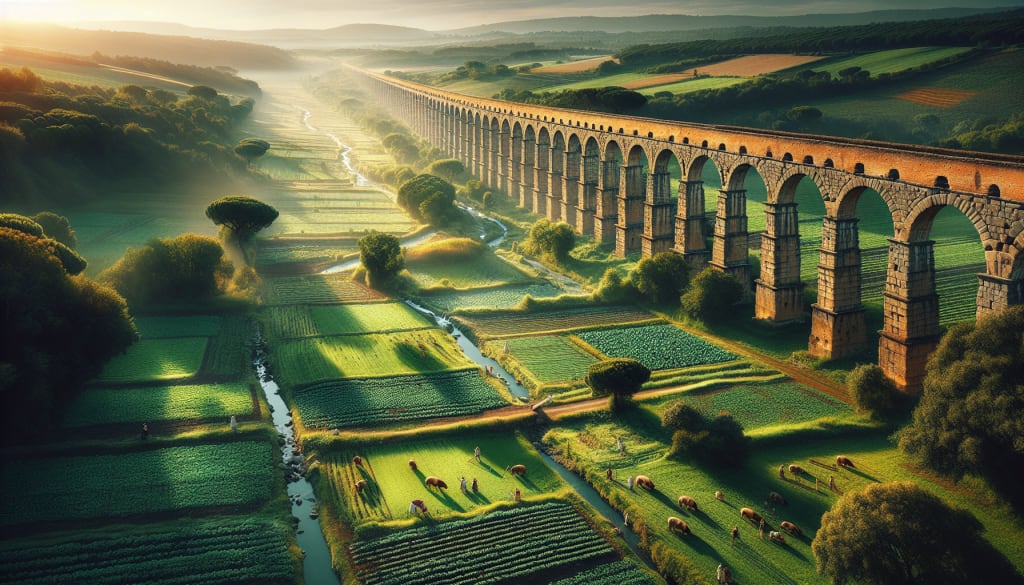Roman Aqueducts: Engineering Marvels of Ancient Civilization
History

Roman aqueducts stand as one of the most impressive feats of engineering from the ancient world, showcasing the ingenuity and technical prowess of Roman civilization. These remarkable structures, designed to transport water over long distances, highlight the Romans' advanced understanding of hydraulics, architecture, and urban planning. Built to supply cities, agricultural lands, and public baths, the aqueducts played a crucial role in sustaining the health and prosperity of Roman society, leaving a lasting legacy that continues to inspire modern engineering.
The Roman aqueduct system was a marvel of both design and function. Using gravity to guide water from springs and rivers to urban centers, the aqueducts were constructed with precise gradients that ensured a steady flow. This required meticulous planning and execution, as even a slight miscalculation could disrupt the water supply. The aqueducts often spanned vast distances, with some extending over 50 miles, and incorporated various structural elements such as tunnels, bridges, and siphons to navigate the challenging terrain.
One of the most famous examples of Roman aqueduct engineering is the Pont du Gard in southern France. This towering structure, built in the first century AD, spans the Gardon River and stands as a testament to the Romans' ability to blend functionality with aesthetic beauty. The aqueduct's three tiers of arches not only provide the necessary support for the water channel but also create a visually striking monument that has endured the test of time. The precision and durability of such constructions underscore the high level of skill and knowledge possessed by Roman engineers.
The construction of Roman aqueducts required a massive workforce and significant resources. Skilled laborers, including engineers, stonemasons, and slaves, worked together to build these monumental structures. The use of durable materials such as concrete and stone, combined with advanced construction techniques, ensured the longevity of the aqueducts. Many of these ancient systems continued to function for centuries, a testament to their robust design and construction.
The impact of Roman aqueducts on daily life in the empire was profound. By providing a reliable supply of fresh water, the aqueducts enabled the growth of cities and improved public health. Access to clean water reduced the spread of diseases and supported the development of public baths, fountains, and latrines, which became central features of Roman urban life. The aqueducts also facilitated agricultural productivity by irrigating farmlands, contributing to the overall prosperity of the Roman economy.
The Romans' approach to aqueduct construction reflected their practical and innovative mindset. They developed sophisticated techniques for maintaining and repairing these structures, ensuring their continued operation. Regular inspections and maintenance were conducted to clear debris and repair any damage, demonstrating a proactive approach to infrastructure management. This systematic care helped to sustain the aqueducts' functionality over the centuries.
The influence of Roman aqueducts extended beyond the borders of the empire. Their engineering principles and construction techniques were studied and adopted by subsequent civilizations, shaping the development of water management systems in Europe and beyond. The legacy of Roman aqueducts can be seen in modern infrastructure projects that continue to draw inspiration from these ancient masterpieces.
In modern times, the ruins of Roman aqueducts remain a source of fascination and admiration. Archaeologists and engineers study these structures to gain insights into Roman engineering practices and to appreciate the ingenuity behind their design. The enduring presence of aqueduct remnants in landscapes across Europe and the Mediterranean serves as a powerful reminder of the Romans' contribution to the field of engineering and their impact on the development of urban civilization.
In conclusion, Roman aqueducts represent a pinnacle of ancient engineering, reflecting the remarkable ingenuity and technical skill of Roman society. These structures not only provided essential water supplies but also supported the growth and prosperity of cities, enhancing public health and quality of life. The legacy of Roman aqueducts endures in their lasting influence on modern engineering and their continued presence as architectural marvels. As we explore and appreciate these ancient structures, we gain a deeper understanding of the Romans' profound impact on the world and their enduring legacy in the realm of engineering and infrastructure.
About the Creator
Marveline Merab
“History never repeats itself. Man always does.”
― Voltaire
Enjoyed the story? Support the Creator.
Subscribe for free to receive all their stories in your feed. You could also pledge your support or give them a one-off tip, letting them know you appreciate their work.






Comments
There are no comments for this story
Be the first to respond and start the conversation.